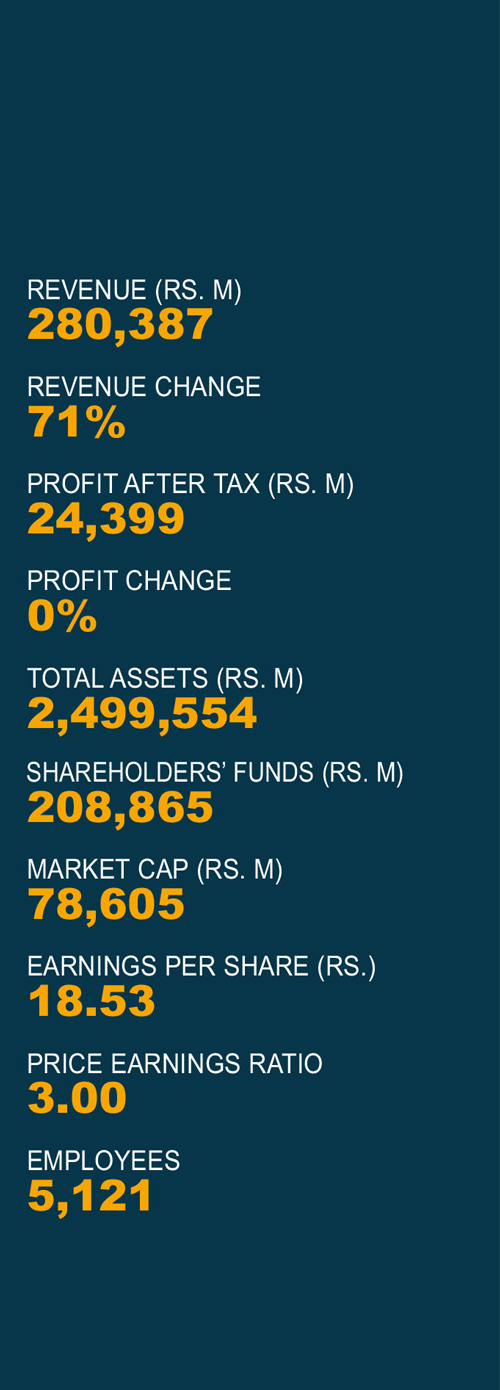COMMERCIAL BANK OF CEYLON
LMD 100 Q&A

Q: How do you perceive the evolution of the bank over the decades?
A: Commercial Bank counts a strong history and heritage as a trade bank in Sri Lanka since its inception as Eastern Bank in 1920.
Today, 103 years later, it is the largest private bank and the benchmark banking institution in the country, serving all Sri Lankans and contributing to the nation’s economic growth.
Presently, Commercial Bank operates a strategically located branch and ATM network in Sri Lanka. Its overseas operations encompass Bangladesh where it has with 20 outlets; Myanmar where it has with a microfinance company in Nay Pyi Taw; and the Maldives where it has with a fully fledged Tier I bank as a majority stakeholder.
While the bank remains committed to serving its trade and corporate clientele, it places equal emphasis on addressing the financial needs of both retail and SME customers, fulfilling the diverse financial aspirations of all Sri Lankans.
Commercial Bank is also one of the pioneers of digital transformation in the industry. Over a century, and underscored by its consumer-centric approach, Commercial Bank has sustained its passion and focus to become the largest private bank in the country, as well as the most awarded one.

Q: What is your assessment of Sri Lanka’s economic path, given the multiple crises the nation has faced in recent times?
A: Currently, Sri Lanka is better poised to reestablish its global stance thanks to a stabilised currency, improved macroeconomic indicators, bolstered investor confidence and growing reserves.
However, economic recovery after a downturn is a complex process and the immediate focus should be on sustaining stability while emphasising a production-based – particularly, export driven – economy.
Q: What are the main challenges facing the sector that your organisation is a part of?
A: The banking sector’s future hinges on political and economic stability, reserve status, international investor confidence, the final outcome of the debt restructuring, policy consistency and sustained digital evolution.
The greatest challenge will be to maintain capital buffers, liquidity and foreign currency reserves.
Moreover, internal cost escalations have been projected for this sector for investments in technology, staffing and recovery processes. This will result in a tougher environment for banks to support an export-oriented manufacturing economy.
Despite the prevailing challenging conditions, the banking sector persisted with its digital transformation.

Q: To what extent are AI-based technological advancements impacting your sector?
A: Innovative technologies are not only seen as tools to improve operational efficiency but catalysts for a fundamental transformation in the way banks build their business models around customer journeys.
Data analytics serves as the cornerstone of the banking sector’s adaptation to this rapidly evolving environment. In turn, this facilitates the enhancement of operational efficiency and enables banks to maintain their competitive edge.
AI and machine learning (ML) have emerged as pivotal technologies in the banking sector. One of the most prominent applications of artificial intelligence and ML in banking is personalised services – while assisting in fraud detection and streamlining internal processes.
The era of ‘bionic banking’ – with digital platforms powered by AI and a human touch – has arrived.

Q: Aligning organisational performance with environmental sustainability – how is this addressed by the bank?
A: Commercial Bank follows a meticulously crafted sustainability strategy and blueprint as the guiding principle for its sustainable activities – based on the key pillars of sustainable banking, responsible organisation and community impact.
Further, eight core areas have been delineated, which are further aligned with seven UN Sustainable Development Goals (SDGs). And finally, the bank’s annual business objectives are aligned with sustainability targets.
In addition, measurement mechanisms include quarterly sustainability dashboards presented to the management – and internal dashboards compiled by the Sustainability Steering Committee. An Integrated Risk Management Department analyses all aspects of risk. Environmental risks associated with lending projects are screened with a comprehensive Social and Environmental Management System (SEMS) framework.
The bank also reviews its economic, environmental, social, human rights, societal and product responsibility – ranked on significance to operations and materiality to the bank, as well as to relevant stakeholders.
Telephone 2486000 | Email: info@combank.net | Website: www.combank.lk




